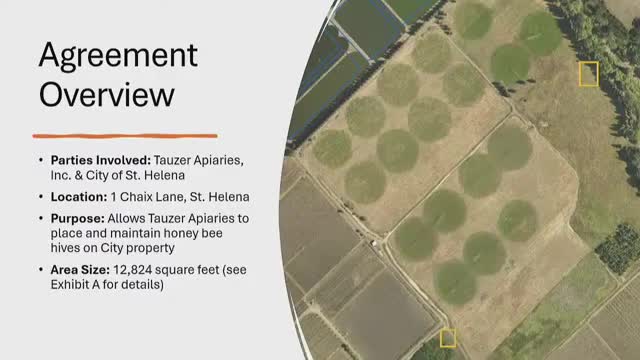Saint Helena City Council Approves Tauzer Apiaries' Honeybee Hive Placement Agreement
July 23, 2025 | Saint Helena, Napa County, California
This article was created by AI summarizing key points discussed. AI makes mistakes, so for full details and context, please refer to the video of the full meeting. Please report any errors so we can fix them. Report an error »

In a recent meeting of the St. Helena City Council, a proposal to establish a lease agreement with Tauzer Apiaries for the placement of honeybee hives on city property sparked a lively debate among council members and community members alike. The proposed site, located at the wastewater treatment plant, encompasses nearly 13,000 square feet of land that is currently underutilized.
The agreement aims to promote sustainable agriculture and enhance local ecosystems by allowing Tauzer Apiaries to maintain honeybee hives, which are crucial for pollination. The city would receive an annual fee of $500 for the use of the land, a nominal amount that raised eyebrows among some council members who questioned the overall benefit of the arrangement.
Concerns were voiced regarding the potential environmental impact of introducing a large number of honeybees into the area, particularly their competition with native pollinators. Local beekeepers and environmental advocates expressed fears that the influx of commercial hives could disrupt the delicate balance of the ecosystem, stressing that honeybees, being generalists, could outcompete native bees for limited floral resources.
During the meeting, Tauzer Apiaries' representative addressed these concerns, suggesting that the hives could be limited to the fall and winter months when native pollinators are less active. This proposal aimed to mitigate competition and reduce the risk of disease transmission among bee populations. However, many community members remained skeptical, emphasizing the need for a thorough environmental assessment to establish a baseline for native bee populations before proceeding.
The council members grappled with the implications of the agreement, weighing the potential benefits of honey production and pollination against the risks posed to local biodiversity. As discussions unfolded, it became clear that the decision would not only affect the immediate area but also reflect the city’s commitment to environmental stewardship and community health.
As the meeting concluded, the council faced a pivotal decision: to approve the resolution and move forward with the lease agreement or to heed the concerns of local stakeholders and reconsider the implications of introducing commercial beekeeping to their community. The outcome remains uncertain, but the dialogue surrounding the proposal highlights the ongoing struggle to balance agricultural practices with ecological preservation in Napa County.
The agreement aims to promote sustainable agriculture and enhance local ecosystems by allowing Tauzer Apiaries to maintain honeybee hives, which are crucial for pollination. The city would receive an annual fee of $500 for the use of the land, a nominal amount that raised eyebrows among some council members who questioned the overall benefit of the arrangement.
Concerns were voiced regarding the potential environmental impact of introducing a large number of honeybees into the area, particularly their competition with native pollinators. Local beekeepers and environmental advocates expressed fears that the influx of commercial hives could disrupt the delicate balance of the ecosystem, stressing that honeybees, being generalists, could outcompete native bees for limited floral resources.
During the meeting, Tauzer Apiaries' representative addressed these concerns, suggesting that the hives could be limited to the fall and winter months when native pollinators are less active. This proposal aimed to mitigate competition and reduce the risk of disease transmission among bee populations. However, many community members remained skeptical, emphasizing the need for a thorough environmental assessment to establish a baseline for native bee populations before proceeding.
The council members grappled with the implications of the agreement, weighing the potential benefits of honey production and pollination against the risks posed to local biodiversity. As discussions unfolded, it became clear that the decision would not only affect the immediate area but also reflect the city’s commitment to environmental stewardship and community health.
As the meeting concluded, the council faced a pivotal decision: to approve the resolution and move forward with the lease agreement or to heed the concerns of local stakeholders and reconsider the implications of introducing commercial beekeeping to their community. The outcome remains uncertain, but the dialogue surrounding the proposal highlights the ongoing struggle to balance agricultural practices with ecological preservation in Napa County.
View full meeting
This article is based on a recent meeting—watch the full video and explore the complete transcript for deeper insights into the discussion.
View full meeting
